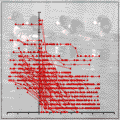|
||||||||||||||||||||||||||||||||||||||||||||||||||||||||||||||||||||||||||||||||||||||||||||||||||||||||||||||||||||||||
|
||||||||||||||||||||||||||||||||||||||||||||||||||||||||||||||||||||||||||||||||||||||||||||||||||||||||||||||||||||||||
| Clutch and brood survivorship |
DOWNLOAD |
|||||||||||||||||||||||||||||||||||||||||||||||||||||||||||||||||||||||||||||||||||||||||||||||||||||||||||||||||||||||
|
This application estimates survival rates from periodically collected data on the number of eggs and/or juveniles in followed clutches and/or broods of an egg-laying species. Publication: Smith, B.D., W.S. Boyd, and M.R. Evans 2003. A statistical model discriminating random and correlated mortality from laying to fledging: Barrow’s Goldeneye as an example. Ecological Applications (submitted). Abstract: Quantitative conservation methodologies such as Population Viability Analysis (PVA) require reliable measurements of life history parameters such as breeding success. The utility of such metrics for egg-laying species is complicated by our knowledge that the mortality of eggs in a clutch and juveniles in a brood can occur both randomly and independently over time, or catastrophically, such as in the sudden loss of a clutch or brood. Not knowing the nature of breeding mortality events caused by either or both of abiotic (e.g., weather, pesticides) and biotic (e.g., predation, habitat alteration) circumstances limits our ability to confidently assess a population’s demography and sustainability, or test competing hypotheses. Using the seaduck Barrow’s Goldeneye as an example, we describe a multinomial likelihood model that estimates egg and juvenile survival rates continuously from laying to fledging based on periodic observations of individual clutches and broods. Adjunct data, such as environmental or predation threat measurements, can be included as covariate series for evaluating their influence on the predicted survival rates of juveniles in a brood. In our example we conclude that expected brood size on hatch day is strongly positively correlated with the probability a juvenile Barrow’s Goldeneye will survive to fledge. We also discuss how knowledge of the effect of an environmental variable on breeding success interpreted from our model can guide conservation strategies that manipulate that variable. Our model has a distinctive ability to statistically characterize mortality between the extremes of random and catastrophic mortality; and can determine if unwitnessed mortalities occurred independently or were correlated (i.e., overdispersed, where catastrophe is extreme overdispersion). Overdispersion is estimated as a parameter of the beta-binomial probability distribution of survivals, and thus differs from its treatment in Program MARK where overdispersion is an a posteriori diagnostic referred to as c-hat.
|
||||||||||||||||||||||||||||||||||||||||||||||||||||||||||||||||||||||||||||||||||||||||||||||||||||||||||||||||||||||||
